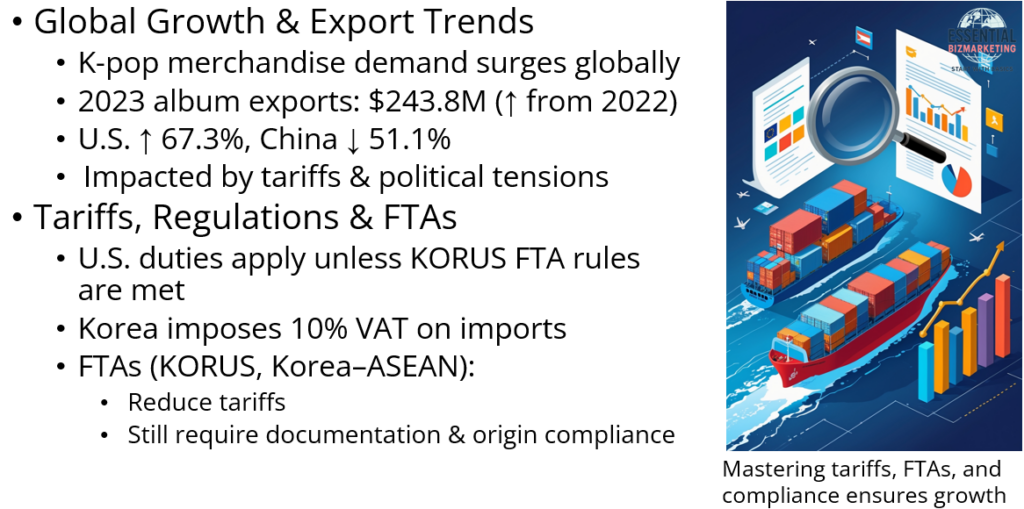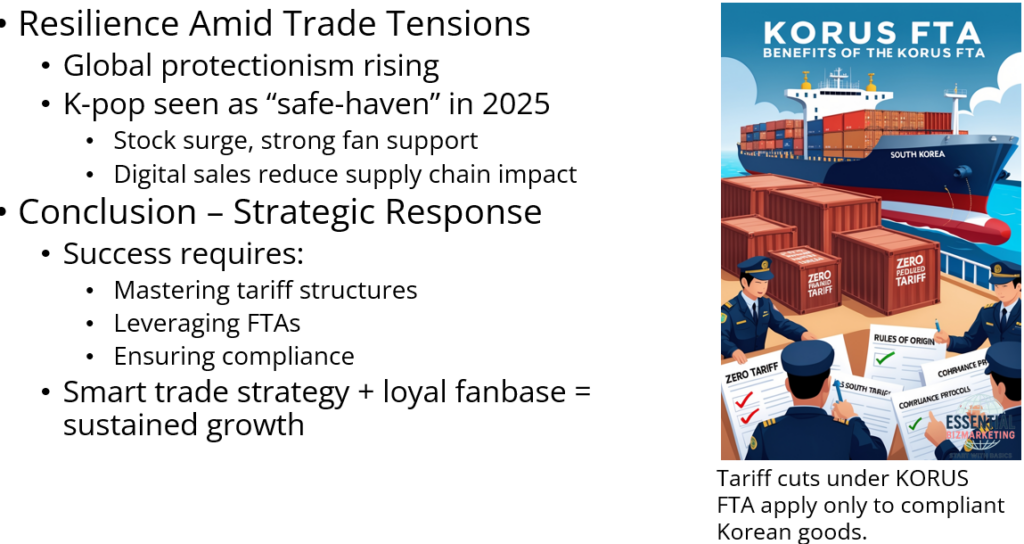Introduction: The Global Rise of K-Pop Merchandise

As K-Pop has become a global cultural phenomenon, demand for related merchandise and physical albums has surged across continents. From official lightsticks and photo cards to deluxe box sets, these products are now shipped worldwide. However, behind the scenes, their cross-border distribution is shaped by a complex web of tariff systems, customs regulations, and free trade agreements that vary from country to country.
Export Dynamics and Tariff Implications
Korea’s export of K-pop albums reached $243.8 million between January and October 2023, already surpassing the full-year total from 2022. Japan, the United States, and China were the largest importers during this period. While exports to the U.S. rose 67.3% year-on-year, shipments to China declined sharply by 51.1%, partly due to political tensions and regulatory barriers. These shifts demonstrate how both tariffs and diplomatic relations shape the global distribution landscape.
Navigating Import Regulations and Local Tariffs
Countries like the U.S. impose specific customs duties on imported goods, including albums and merchandise. The KORUS FTA offers reduced or zero tariffs for South Korean products, but only if rules of origin and compliance protocols are properly met. In contrast, South Korea imposes a 10% value-added tax (VAT) on imports, in addition to any excise duties, which affects imported goods like foreign fan merchandise or K-pop products produced overseas.
Trade Agreements as a Strategic Lever
Free Trade Agreements (FTAs) like KORUS and Korea–ASEAN FTAs help streamline cross-border transactions by reducing or eliminating tariffs. For example, under KORUS, eligible Korean cultural products can enter the U.S. with minimal barriers, supporting Korean labels’ overseas expansion. Still, administrative hurdles like documentation, customs inspections, and rule-of-origin certifications remain significant factors affecting delivery time and costs.
Challenges Amid Global Trade Tensions

Amid U.S.–China tariff disputes and rising global protectionism, K-pop has oddly benefited. In 2025, entertainment stocks in Korea surged as investors treated K-pop companies like “safe-haven assets.” The global devotion of fanbases and high online sales helped shield the industry from some of the supply chain shocks and market volatility affecting other sectors.
Conclusion: Strategic Approaches for Global Growth
As K-pop companies continue their international expansion, mastering the logistics of global distribution becomes as essential as content creation. Understanding tariff structures, leveraging FTAs, and maintaining legal compliance are crucial for sustained growth. With smart trade strategy and strong fan engagement, the K-pop industry is poised to thrive—despite the occasional customs checkpoint.
📚 References
Korea JoongAng Daily. (2023, November 27). K-pop album exports reach record high. https://koreajoongangdaily.joins.com/news/2023-11-27/business/industry/Kpop-album-exports-reach-record-high/1922106
The Guardian. (2025, February 12). Going for a song: investors flee to K-pop as safe haven amid Trump’s tariff war. https://www.theguardian.com/music/2025/feb/12/donald-trump-tariffs-k-pop-group-investments-soar-stock-market-safe-haven
U.S. Customs and Border Protection. (n.d.). Korea Free Trade Agreement (KORUS). https://www.cbp.gov/trade/free-trade-agreements/korea
U.S. International Trade Administration. (2023). South Korea – Import Tariffs. https://www.trade.gov/country-commercial-guides/south-korea-import-tariffs
📁 Start exploring the Blog
📘 Or learn more About this site
🧵 Or follow along on X (Twitter)
🔎 Looking for sharp perspectives on global trade and markets?
I recommend @GONOGO_Korea as a resource I trust and regularly learn from.
